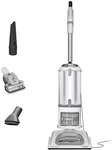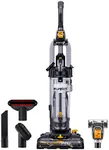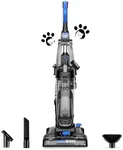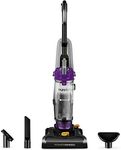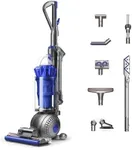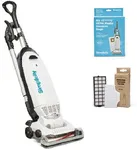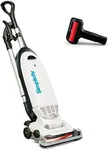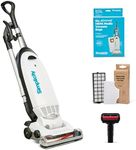Buying Guide for the Best Upright Bagless Vacuums
Choosing an upright bagless vacuum can make cleaning easier and more convenient since you don't have to buy and replace bags. It’s important to focus on what suits your home and lifestyle—think about the types of floors you have, whether you have pets, and the features that might make vacuuming less of a chore for you. By understanding the core specifications, you can pick a vacuum that cleans efficiently, is not too heavy to handle, and captures dust effectively for your specific needs.Suction PowerSuction power refers to how strongly the vacuum can pull in dirt and debris. It’s vital because stronger suction means better cleaning, especially on carpets or for pet hair. Usually, this is measured in air watts or similar terms, but higher isn’t always better for everyone. For light cleaning or mostly hard floors, a moderate suction is often enough and may use less energy. If you have thick carpets or pets, look for higher suction to ensure deep cleaning. Think about your main messes and floor types to guide you.
Dustbin CapacityThis is the size of the chamber that holds dirt and debris. It’s important because a larger dustbin means you can clean more before having to empty it. Dustbin sizes can range from compact (under 1 liter) to extra large (over 2 liters). Small dustbins are lighter and easier to handle, but need frequent emptying�—ideal for smaller spaces. Larger ones are better for big homes or infrequent emptying but can make the vacuum heavier. Choose based on how often you want to empty the bin versus the size you’re comfortable with.
Filtration SystemThe filtration system determines how well the vacuum traps dust and allergens inside. HEPA filters capture very fine particles and are recommended if you have allergies or want cleaner air. Other systems may trap larger particles but let fine dust out, which is less ideal for sensitive users. If allergies are a concern, prefer a vacuum that boasts HEPA or similar advanced filtration, and check if filters are washable or need replacing.
WeightWeight indicates how heavy the vacuum is to push, pull, and carry. Lightweight models (typically under 10 pounds) are easier to maneuver and better for stairs or elderly users, while heavier vacuums may have stronger suction and more features. If you struggle with lifting or have a multi-level home, a lighter vacuum is more practical. For single-floor homes and those who value deep cleaning, a heavier vacuum might be fine.
Cord LengthCord length determines how far you can go from your power outlet before needing to switch. Shorter cords (under 20 feet) are easier to store but limit reach, while longer cords (over 25 feet) provide more freedom for cleaning large rooms. If you have many big spaces or few outlets, go for a longer cord. In a small apartment, a shorter cord should be enough.
Brush Roll FeaturesThe brush roll agitates carpet fibers to lift dirt and is a key feature in upright vacuums. Some models offer on/off switches or tangle-free designs to deal with hair. If you have mostly hard floors, a brush roll that can be turned off is helpful to avoid scattering debris. For carpeted homes or pet owners, focus on a strong, tangle-resistant brush roll.
Accessories and AttachmentsAttachments like crevice tools, dusting brushes, and pet hair tools expand the vacuum's usability. They matter most if you plan to clean above-floor surfaces, upholstery, or tight spots. If you only vacuum floors, you may not need many extras, but if you have pets, stairs, or furniture to clean, look for models with specific attachments for those jobs.
